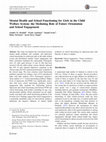Papers by Wendy Auslander
Children and Youth Services Review

Child maltreatment, 2018
Home visitation (HV) interventions may hold promise to improve parenting and prevent child maltre... more Home visitation (HV) interventions may hold promise to improve parenting and prevent child maltreatment recidivism in families reported to child protective services (CPS) with young children, but this has rarely been studied. Findings are presented from an 18-month randomized controlled trial in which intact families ( N = 122) with at least one CPS report were provided with a facilitated connection to a paraprofessional evidence-based HV program or usual care services from child protection. Results are reported for changes in maternal stress, depression, and social support outcomes and repeat reports to CPS. No significant changes were found in maternal outcomes by group. Among nondepressed mothers or families without multiple CPS reports prior to study enrollment, HV was associated with a significantly lower likelihood of CPS report recidivism. These results indicate potential for HV to prevent maltreatment recidivism but suggest that higher intensity intervention is warranted for...

Evaluation and program planning, Feb 1, 2018
Young children in families contacting the child welfare system are at high risk of recurrent malt... more Young children in families contacting the child welfare system are at high risk of recurrent maltreatment and poor developmental outcomes. Home visitation programs to support parenting may offer hope as a preventive resource but these programs are rarely linked with child welfare. This article describes findings from a formative evaluation of a program designed to connect child welfare-involved families to an existing evidence-supported home visitation program. The program, Early Childhood Connections (ECC), was developed by a field-university partnership including leaders from a public state child welfare system, regional early childhood education systems, and several local agencies providing family support services. Despite extensive and rigorous planning by the workgroup and collaborative refining of the intervention approach as agency needs changed, the continued structural and policy changes within both the home visitation agency and the child welfare agencies created significa...

School Mental Health
This study investigated the association between mental health problems and academic and behaviora... more This study investigated the association between mental health problems and academic and behavioral school functioning for adolescent girls in the child welfare system and determined whether school engagement and future orientation meditated the relationship. Participants were 231 girls aged between 12 and 19 who had been involved with the child welfare system. Results indicated that 39% of girls reported depressive symptoms in the clinical range and 54% reported posttraumatic symptoms in the clinical range. The most common school functioning problems reported were failing a class (41%) and physical fights with other students (35%). Participants reported a mean number of 1.7 school functioning problems. Higher levels of depression and PTSD were significantly associated with more school functioning problems. School engagement fully mediated the relationship between depression and school functioning and between PTSD and school functioning, both models controlling for age, race, and placement stability. Future orientation was not significantly associated with school functioning problems at the bivariate level. Findings suggest that school engagement is a potentially modifiable target for interventions aiming to ameliorate the negative influence of mental health problems on school functioning for adolescent girls with histories of abuse or neglect.

Research on Social Work Practice
Objective: The purpose of this study is to describe the results of a process and outcome evaluati... more Objective: The purpose of this study is to describe the results of a process and outcome evaluation of a culturally specific, peer-led, dietary change program designed to reduce the risk of noninsulin-dependent diabetes mellitus (NIDDM) among low-income African American women. Method: Using an experimental, control-group design, 239 African American women completed pretest and posttest interviews that included measures of nutrition-related knowledge, attitudes, behaviors, fat intake, and weight. Results: Significant reductions in fat intake were found among women in the treatment condition. Participants significantly increased low-fat dietary patterns and showed higher levels of nutrition-related knowledge. Examination of physical data indicates that no significant weight differences were found between the treatment and control groups. Conclusions: This model of health promotion, which individually tailors the intervention content through staging and used community organization stra...
Child and Adolescent Social Work Journal

Journal of Interpersonal Violence, 2017
Childhood abuse is a common experience for youth in the child welfare system, increasing their ri... more Childhood abuse is a common experience for youth in the child welfare system, increasing their risk of bullying perpetration and victimization. Little research exists that has examined the rates of bullying perpetration and victimization for child welfare–involved adolescent girls. The study addressed the following aims: (a) to generate frequency estimates of physical, nonphysical, and relational forms of bullying perpetration and victimization; (b) to identify the frequency of bully-only, victim-only, bully-victim, and noninvolved roles; and (c) to identify risk and protective factors that correlate with these bullying role types. Participants were 236 girls (12-19 years) in the child welfare system from a Midwestern urban area. Participants were referred to the study to join a trauma-focused group program. Seventy-five percent of the total sample were youth of color, with the remaining 25% identifying as White, non-Hispanic. Data were collected through baseline surveys that assess...

American Journal of Orthopsychiatry, 2016
This study describes the process of adapting and implementing Girls Aspiring toward Independence ... more This study describes the process of adapting and implementing Girls Aspiring toward Independence (GAIN), a trauma-focused, group-based therapy adapted from Cognitive Behavioral Intervention for Trauma in Schools (CBITS) for girls in child welfare. Descriptive data were examined on 3 outcomes: posttraumatic stress disorder (PTSD), depression, and social problem-solving skills among adolescent girls in the child welfare system. Qualitative and quantitative methods were utilized to inform the adaptation of the CBITS intervention, evaluate feasibility, treatment fidelity, and acceptability, and to test the effects of the intervention. Girls ages 12 to 18 (N = 27) were randomly assigned to the experimental and usual care conditions. Participants' symptoms of PTSD and depression and social problem-solving skills were evaluated at pre, post- (3 months), and follow-up (6 months) assessments.…

Journal of Child & Adolescent Trauma, 2016
This study investigated the relationship between histories of childhood abuse and aggressive beha... more This study investigated the relationship between histories of childhood abuse and aggressive behaviors among adolescent girls involved in child welfare, and determined whether symptoms of post-traumatic stress and depression mediated this relationship. Participants were 237 girls ages 12-19 years. Overall, results indicated 89 % of the adolescents endorsed at least one aggressive behavior towards others. Specifically, 72.0 % engaged in physical aggression, 78.5 % engaged in non-physical aggression, and 51.5 % endorsed relational aggression. Greater severity of emotional and physical abuse were significantly associated with a higher frequency of aggressive behaviors. Sexual abuse was not significantly related to aggression. Post-traumatic stress and depression fully mediated the relationship between emotional abuse and aggression, controlling for race, service use, and living situation. The linkages between physical abuse and aggression were not mediated by either post-traumatic stress or depression. Findings suggest that among adolescent girls with histories of emotional abuse, post-traumatic stress and depression represent potential modifiable risk factors to target for reducing aggression.
Children and Youth Services Review, 2016
Child Indicators Research, 2016

Health and Social Work, Aug 1, 1997
Patient satisfaction is an important indicator of medical outcomes. This study used an ecological... more Patient satisfaction is an important indicator of medical outcomes. This study used an ecological framework to identify sociodemographic, family, and community predictors of mothers' satisfaction with their children's medical care and to determine the extent to which satisfaction is associated with medical outcomes such as adherence to treatment and health status of children with diabetes. Although individual demographics have little influence on satisfaction, family and community stressors are significant predictors of mothers' satisfaction with medical care. Mothers who reported greater perceptions of racism and family stress were significantly less satisfied with their children's medical care than those from less stressful environments. Mothers' satisfaction with medical care was significantly associated with adherence but was not significantly related to the children's health status.

ABSTRACT BACKGROUND AND PURPOSE: Sexual minority youths (SMY) experience substantially higher rat... more ABSTRACT BACKGROUND AND PURPOSE: Sexual minority youths (SMY) experience substantially higher rates of bullying victimization and mental health problems compared to heterosexual peers. The general adolescent bullying literature has identified important individual, family, and peer-level risk and protective factors to bullying victimization that remain largely unexplored with SMY (child abuse, mental health problems, and peer-level social support). This is an important research gap, because SMY also report more physical and sexual child abuse than their heterosexual counterparts. Utilizing a community-based sample of SMY, this presentation will address the following research questions: (1) What are the frequencies of bullying victimization by type (verbal, relational, electronic, and physical) within the last school year, (2) What are the associations between four types of bullying victimization and individual (demographics, gender-role nonconformity, psychological distress, and sexuality disclosure), family (emotional, physical, and sexual abuse), and peer-level (friend and classmate support) risk and protective factors, (3) Do mental health problems mediate the relationship between child abuse and bullying victimization, and (4) Does peer-level social support moderate this mediated relationship? METHODS: The study utilized a risk and resiliency theoretical framework and a cross-sectional, quantitative design. Structured, face-to-face interviews were conducted with a convenience sample of 125 SMY. The participants were recruited from two community-based organizations located in the Midwest. Eligibility requirements were 15-19 years old, self-identification as non-heterosexual, and currently not living in foster care. The study utilized several preexisting measures: Swearer Bullying Survey, Brief Symptom Inventory, Childhood Trauma Questionnaire, and Child and Adolescent Social Support Scale. Gender-role nonconformity and sexuality disclosure were measured by adapting items used previously in studies with SMY. RESULTS: The majority of SMY reported being bullied in their lifetime (93.6%) and within the last school year (75.2%). Verbal bullying victimization was the most frequent type with 31.2% reporting weekly to daily experiences. Significant bivariate relationships were found between (a) child abuse and bullying victimization and (b) psychological distress and bullying victimization. Higher levels of child abuse and psychological distress were associated with higher frequencies of multiple types of bullying victimization. Gender-role nonconformity and sexuality disclosure were not significantly associated with bullying victimization. Psychological distress was found to fully mediate the relationship between child abuse and bullying victimization. This mediated relationship was conditioned upon the level of friend support. This conditional indirect effect of child abuse on bullying victimization decreased as SMY reported higher levels of friend support. Methodological limitations of the study included a non-causal research design, self-report versus teacher and peer measures of bullying victimization, and possible sample bias due to community-based recruitment. CONCLUSIONS AND IMPLICATIONS: These findings contribute to the literature by identifying individual, family, and peer-level risk and protective factors to bullying victimization for SMY. Next steps include looking more broadly at other forms of family and peer-level violence (witnessing domestic violence, sibling aggression, neighborhood bullying) as risk factors to revictimization at school. Anti-bullying interventions need to address the potential mental healthcare needs of bullied SMY, while also implementing peer mentor programs to increase friend and classmate support.
Child Welfare, 2003
This study documents the school experiences of 262 youth referred for independent-living preparat... more This study documents the school experiences of 262 youth referred for independent-living preparation from the foster care system of one midwestern U.S. county. Of the youth, 73% had been suspended at least once since the seventh grade, and 16% had been expelled. In the past year, 58% had failed a class, and 29% had physical fights with students. Yet the group reported high educational aspirations: 70% wanted to attend college. Those in congregate care and family settings often had school behavior problems. The results support the need for a system of education advocates who work to maintain proper education placements for youth in foster care and help them receive the academic resources they need to graduate from high school and proceed to college.

ABSTRACT Background and Purpose: Histories of childhood maltreatment have been linked to poor men... more ABSTRACT Background and Purpose: Histories of childhood maltreatment have been linked to poor mental health and health outcomes in adulthood. The Adverse Childhood Events Study (ACES) has provided strong evidence that childhood abuse is significantly associated with poor health behaviors and poor health outcomes, such as diabetes, heart disease, cancer, and HIV/STD’s in adulthood. Most of the research in this area has examined adults who retrospectively reported childhood abuse, yet little is known about adverse childhood events and health risk factors among adolescents who have substantiated histories of childhood abuse. To better understand this problem, we investigated the relationship between child maltreatment and four health risk factors in adolescent girls who are involved in child welfare. The following question was explored: What is the association of child maltreatment types (emotional abuse, physical abuse, and sexual abuse) with current health risk factors, such as poor eating, risky sexual behaviors, substance use, and depression among adolescent girls involved in child welfare, controlling for service use, medication use, and demographics? Methods: The study utilized baseline data from a trauma-focused CBT study that included 235 adolescent girls, ages 12-19 years (mean = 14.9, SD=1.6). Participants were youths of color (74%, most were African American), and White (26%). The girls lived with biological parents, relatives, or adopted parents (60%), foster homes (27%), and group homes (13%). Structured interviews included the following health risk factors: poor eating (3 items), sexual risk behaviors (6 items), substance use (8 items), and depression (Kovacs, 2003). Independent variables included: 1) emotional abuse (EA), physical abuse (PA), and sexual abuse (SA) (Bernstein & Fink’s Childhood Trauma Questionnaire); 2) demographics (age, race, living situation), and 3) service and medication use. Data analyses included descriptive statistics, simple correlations, MANCOVA, and post-hoc multiple regression analyses for each of the dependent variables. Results: Results indicated that 78% of the girls endorsed poor eating behaviors; 40% endorsed at least one sexual risk behavior, 56% used 1 or more substance; and 21% experienced depressive symptoms at or above the clinical cut-off score. EA was associated with poor eating, substance use, and depressive symptoms (p<.01). PA was associated with substance use and depression (p<.05). SA was associated with all health risk behaviors (p<.05), and depression (p<.001). Results of the MANCOVAS indicated that EA (Wilk’s λ=0.86, p<.001) and SA (Wilk’s λ=0.95, p<.05) were associated with the combined health risk dependent variables, but not PA. The post-hoc multiple regression models for each health risk behavior indicated that EA remained a significant predictor of poor eating, substance use, and depression. SA remained a significant predictor only for depression controlling for the other variables in the model. Conclusions: Findings suggest that exposure to EA is linked to multiple health risks in adolescent girls that increase their chances of morbidity as adults. Experiencing SA increases depressive symptoms which may lead to obesity and diabetes. Knowledge of the types of abuse that may lead to poor health behaviors among adolescents can be utilized to inform disease prevention and health promotion programs for child welfare populations.

Http Dx Doi Org 10 1521 Aeap 13 4 377 21427, May 31, 2005
This study investigates the interrelationships among childhood sexual abuse, other types of child... more This study investigates the interrelationships among childhood sexual abuse, other types of child maltreatment, emotional and behavioral problems, and HIV risk behaviors in a sample of 167 adolescents, aged 15-19, participating in an independent living preparation program in one midwestern county. Thirty-three percent of the youths identified as white and 67% as youths of color. The sample was almost evenly split by gender (51% male and 49% female). Thirty-five percent of the youths (n = 59) reported some form of sexual abuse; 21 reported unwanted touching, with no unwanted intercourse, and 38 reported unwanted intercourse. Multivariate analyses demonstrated a significant relationship between the severity of sexual abuse and youths' recent HIV risk behaviors, after accounting for the contribution of other childhood trauma and emotional and behavioral problems. The findings support the need for HIV prevention programs targeting sexually abused youths.
Child Welfare, Mar 1, 1998

ABSTRACT Background and Purpose: Histories of childhood maltreatment have been linked to victimiz... more ABSTRACT Background and Purpose: Histories of childhood maltreatment have been linked to victimization and interpersonal violence, and girls may be more vulnerable than boys. Few studies have examined the association of child maltreatment types with victimization and the potential pathways involved. Social learning theory suggests that the experience of childhood maltreatment or exposure to family violence increases the risk of later violent outcomes due to learned roles, traumatic reactions, and maladaptive coping skills. For most adolescents who were involved with the child welfare system, their victimization began prior to their adolescent years disrupting normal developmental trajectories which may lead to a lack of assertiveness and a sense of powerlessness (Browne & Finkelhor, 1986). In the present study, we posit that there is a mediating relationship between early exposure to maltreatment and vulnerability to re-victimization through trauma responses. Thus, the following questions were addressed: 1) What is the association of child maltreatment types, i.e., physical abuse, sexual abuse, and physical neglect, with current victimization among adolescent girls, and 2) Does PTSD mediate this relationship? Methods: The study utilized baseline data from a trauma-focused CBT study that included 136 adolescent girls, ages 12-18 years old (mean age=14.8, SD=1.6). The girls were referred by case managers and staff from Child Protective Services. The sample was primarily youths of color—African American (85 %), and White (15 %). The girls’ current living situations were as follows: 59% with biological parents, relatives, or adopted parents; 27% in foster homes; and 14% in group homes. Structured face-to-face interviews included the following variables: 1) Frequency of Aggressive Behaviors—As Victims (18 items) assessing how many times they experienced physical, verbal, and relational aggression in the last 3 months; 2) PTSD symptoms (Foa, 2001), 3) Physical Abuse, Sexual Abuse, and Physical Neglect (Bernstein & Fink’s Childhood Trauma Questionnaire), and 4) Demographics (age, race, living situation). Data analyses included descriptive statistics, simple correlations, and path analysis to evaluate the hypothesis of mediation. Results: Ninety percent of the girls experienced some form of victimization in the last 3 months. Correlational analyses indicated that girls who reported higher levels of physical abuse experienced higher frequencies of aggressive behaviors as victims (r = .23, p<. 01). In contrast, no significant relationships were found between either sexual abuse and physical neglect and aggressive behaviors. Sixty-six percent of the girls endorsed PTSD symptoms in the borderline-clinical range. To determine if PTSD mediated this relationship, a path analysis was conducted. Results showed that higher levels of PTSD was significantly related to higher levels of both physical abuse (B = .27, p<.001) and aggressive behaviors (B = .56, p<.0001). Furthermore, the relationship between physical abuse and aggression was no longer significant (B = .08, p<.27). Bootstrapped confidence intervals (Preacher and Hayes, 2004) confirmed the significant mediating (indirect) effect (p<.05). Conclusions and Implications: One pathway by which physical abuse influences adolescent re-victimization is through PTSD symptoms. Results suggest that trauma treatment to reduce PTSD symptoms may be an important strategy for preventing interpersonal violence in this population.










Uploads
Papers by Wendy Auslander